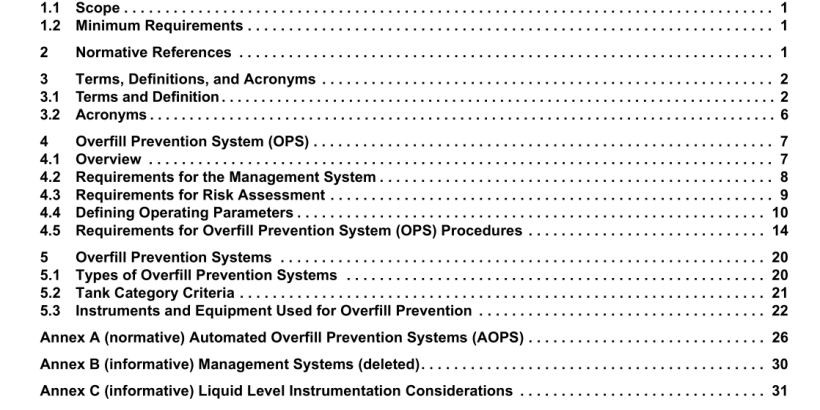ANSI API St 2350-2020 pdf download.Overfill Prevention for Atmospheric Storage Tanks in Petroleum Facilities
4.2 Requirements for the Management System
A management system is the framework of administrative processes and procedures used to enable the owner/operator to fulfill the tasks required to prevent an overfill. A management system is required and shall be documented for conformance with API 2350, but this standard does not specify how to implement nor document such a system. This management system may be integrated with existing safety or environmental procedures or be developed as a stand-alone system. This task is the responsibility of the owner/operator. A properly structured management system provides all the practices and components required for a good OPS and is managed and periodically assessed and updated to keep practices current as people and equipment change. API RP 1173, Pipeline Safety Management Systems, provides some guidance on management systems.
At a minimum, the management system shall address:
a) formal documented operating procedures and practices, including safety and emergency response procedures;
b) competency of operating and maintenance personnel;
c) functional equipment systems, tested and maintained by competent personnel;
d) scheduled inspection and maintenance programs for overfill instrumentation and equipment;
e) systems and procedures to address both normal and abnormal operating conditions;
f) management of change (MOC) process that includes personnel and equipment changes;
g) system to identify, investigate, and communicate overfill near-misses and incidents;
h) system to share lessons learned;
i) follow-up system to address any needed mitigation of circumstances leading to near-misses or incidents;
4.3 Requirements for Risk Assessment
Risk assessment for each tank subject to overfill shall be performed by the owner/operator. Risk assessment methods and procedures may conform to the owner/operator’s procedures. This standard does not specify how risk assessments should be conducted (e.g. qualitative or semi-quantitative, including LOPA), because tank operations, associated risks, corporate risk assessment knowledge, and methods vary widely, and risk tolerance is site- and owner/operator-specific. The owner/operator shall utilize the requirements in 5.2 where the categories (found in Annex G) are used with the associated response times found in 4.4.23 until a risk assessment is undertaken. For a tank that does not fit into a category, the owner/operator shall default to the next more conservative applicable category. Personnel who are familiar with the site-specific tank facilities and operations, personnel familiar with the risk assessment methodology, and personnel who are familiar with impacts to and from the transporter should participate in these analyses. Procedures for performing risk assessments on tank systems subject to overfills should be developed and implemented for use in OPS. These may be either qualitative or quantitative. Annex E provides a conceptual overview for a risk assessment program.
To assess the risk of overfill, the operating procedures and associated instrumentation described in this document and their effectiveness should be evaluated, including:
a) consequences of overfill;
b) operation conditions (max flow rates, number of receipt lines operating at one time to fill tanks);
c) procedures for pre-receipt activities;
d) procedures for activities during receipt;
e) procedures for emergencies, i.e. alarm response;
f) design, testing, operation, and maintenance of instrumentation systems;
g) design and maintenance of OPS.
When a risk assessment shows the acceptance criteria are not satisfied, further risk reduction through additional safeguards including layers of protection (e.g. additional level instruments and procedures) and changes in operations and procedures shall be provided to meet the acceptance criteria. AOPS may provide additional risk reduction; however, it is important to consider the potential for hydraulic surge.ANSI API St 2350-2020 pdf download
